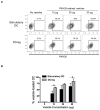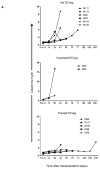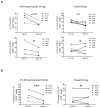Renal Allograft Survival in Nonhuman Primates Infused With Donor Antigen-Pulsed Autologous Regulatory Dendritic Cells
- PMID: 28009481
- PMCID: PMC5444942
- DOI: 10.1111/ajt.14182
Renal Allograft Survival in Nonhuman Primates Infused With Donor Antigen-Pulsed Autologous Regulatory Dendritic Cells
Abstract
Systemic administration of autologous regulatory dendritic cells (DCreg; unpulsed or pulsed with donor antigen [Ag]), prolongs allograft survival and promotes transplant tolerance in rodents. Here, we demonstrate that nonhuman primate (NHP) monocyte-derived DCreg preloaded with cell membrane vesicles from allogeneic peripheral blood mononuclear cells induce T cell hyporesponsiveness to donor alloantigen (alloAg) in vitro. These donor alloAg-pulsed autologous DCreg (1.4-3.6 × 106 /kg) were administered intravenously, 1 day before MHC-mismatched renal transplantation to rhesus monkeys treated with costimulation blockade (cytotoxic T lymphocyte Ag 4 immunoglobulin [CTLA4] Ig) and tapered rapamycin. Prolongation of graft median survival time from 39.5 days (no DCreg infusion; n = 6 historical controls) and 29 days with control unpulsed DCreg (n = 2), to 56 days with donor Ag-pulsed DCreg (n = 5) was associated with evidence of modulated host CD4+ and CD8+ T cell responses to donor Ag and attenuation of systemic IL-17 production. Circulating anti-donor antibody (Ab) was not detected until CTLA4 Ig withdrawal. One monkey treated with donor Ag-pulsed DCreg rejected its graft in association with progressively elevated anti-donor Ab, 525 days posttransplant (160 days after withdrawal of immunosuppression). These findings indicate a modest but not statistically significant beneficial effect of donor Ag-pulsed autologous DCreg infusion on NHP graft survival when administered with a minimal immunosuppressive drug regimen.
Keywords: T cell biology; animal models: nonhuman primate; basic (laboratory) research/science; dendritic cell; fusion proteins and monoclonal antibodies: belatacept; immunobiology; immunosuppressant; immunosuppression/immune modulation; kidney transplantation/nephrology; mechanistic target of rapamycin (mTOR); translational research/science.
© 2016 The American Society of Transplantation and the American Society of Transplant Surgeons.
Conflict of interest statement
The authors of this manuscript have conflicts of interest to disclose as described by the American Journal of Transplantation. AWT is co-inventor of a US patent for generation of dendritic cells to promote organ transplant survival. The other authors have no conflicts of interest to disclose.
Figures











Similar articles
-
Generation and functional assessment of nonhuman primate regulatory dendritic cells and their therapeutic efficacy in renal transplantation.Cell Immunol. 2020 May;351:104087. doi: 10.1016/j.cellimm.2020.104087. Epub 2020 Mar 12. Cell Immunol. 2020. PMID: 32197811 Free PMC article. Review.
-
Donor-Derived Regulatory Dendritic Cell Infusion Maintains Donor-Reactive CD4+CTLA4hi T Cells in Non-Human Primate Renal Allograft Recipients Treated with CD28 Co-Stimulation Blockade.Front Immunol. 2018 Feb 19;9:250. doi: 10.3389/fimmu.2018.00250. eCollection 2018. Front Immunol. 2018. PMID: 29520267 Free PMC article.
-
Regulatory dendritic cell infusion prolongs kidney allograft survival in nonhuman primates.Am J Transplant. 2013 Aug;13(8):1989-2005. doi: 10.1111/ajt.12310. Epub 2013 Jun 11. Am J Transplant. 2013. PMID: 23758811 Free PMC article.
-
Eomesodermin(lo) CTLA4(hi) Alloreactive CD8+ Memory T Cells Are Associated With Prolonged Renal Transplant Survival Induced by Regulatory Dendritic Cell Infusion in CTLA4 Immunoglobulin-Treated Nonhuman Primates.Transplantation. 2016 Jan;100(1):91-102. doi: 10.1097/tp.0000000000000871. Transplantation. 2016. PMID: 26680373 Free PMC article.
-
Regulatory dendritic cells for promotion of liver transplant operational tolerance: Rationale for a clinical trial and accompanying mechanistic studies.Hum Immunol. 2018 May;79(5):314-321. doi: 10.1016/j.humimm.2017.10.017. Epub 2017 Oct 31. Hum Immunol. 2018. PMID: 29100944 Free PMC article. Review.
Cited by
-
Donor myeloid derived suppressor cells (MDSCs) prolong allogeneic cardiac graft survival through programming of recipient myeloid cells in vivo.Sci Rep. 2020 Aug 28;10(1):14249. doi: 10.1038/s41598-020-71289-z. Sci Rep. 2020. PMID: 32859934 Free PMC article.
-
Transplant research in nonhuman primates to evaluate clinically relevant immune strategies in organ transplantation.Transplant Rev (Orlando). 2019 Jul;33(3):115-129. doi: 10.1016/j.trre.2019.03.002. Epub 2019 Apr 5. Transplant Rev (Orlando). 2019. PMID: 31027947 Free PMC article. Review.
-
Memory T cells are significantly increased in rejected liver allografts of rhesus monkeys.Liver Transpl. 2018 Feb;24(2):256-268. doi: 10.1002/lt.24983. Liver Transpl. 2018. PMID: 29150986 Free PMC article.
-
Generation and functional assessment of nonhuman primate regulatory dendritic cells and their therapeutic efficacy in renal transplantation.Cell Immunol. 2020 May;351:104087. doi: 10.1016/j.cellimm.2020.104087. Epub 2020 Mar 12. Cell Immunol. 2020. PMID: 32197811 Free PMC article. Review.
-
Tolerogenic Dendritic Cells in Solid Organ Transplantation: Where Do We Stand?Front Immunol. 2018 Feb 19;9:274. doi: 10.3389/fimmu.2018.00274. eCollection 2018. Front Immunol. 2018. PMID: 29520275 Free PMC article. Review.
References
-
- Wood KJ, Bushell A, Hester J. Regulatory immune cells in transplantation. Nat Rev Immunol. 2012;12(6):417–430. - PubMed
-
- Lombardi G, Sagoo P, Scotta C, Fazekasova H, Smyth L, Tsang J, et al. Cell therapy to promote transplantation tolerance: a winning strategy? Immunotherapy. 2011;3(4 Suppl):28–31. - PubMed
-
- Todo S, Yamashita K, Goto R, Zaitsu M, Nagatsu A, Oura T, et al. A pilot study of operational tolerance with a regulatory T-cell-based cell therapy in living donor liver transplantation. Hepatology. 2016;64(2):632–643. - PubMed
-
- Hutchinson JA, Riquelme P, Sawitzki B, Tomiuk S, Miqueu P, Zuhayra M, et al. Cutting Edge: Immunological consequences and trafficking of human regulatory macrophages administered to renal transplant recipients. J Immunol. 2011;187(5):2072–2078. - PubMed
MeSH terms
Substances
Grants and funding
LinkOut - more resources
Full Text Sources
Other Literature Sources
Medical
Research Materials
Miscellaneous

